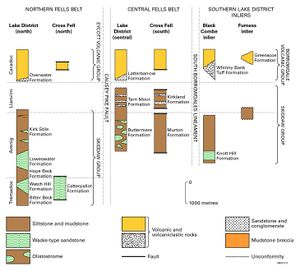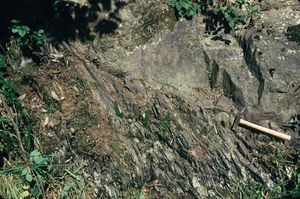Basin uplift and volcanism, Skiddaw and Manx groups, early Ordovician, Northern England
| From: Stone, P, Millward, D, Young, B, Merritt, J W, Clarke, S M, McCormac, M and Lawrence, D J D. 2010. British regional geology: Northern England. Fifth edition. Keyworth, Nottingham: British Geological Survey. |
Introduction



The first indications of volcanic activity during Skiddaw Group deposition are seen in the early Llanvirn, with sporadic interbeds of volcaniclastic turbidite sandstone and bentonite ash in the Tarn Moor and Kirkland formations of the Central Fells Belt (P916041). Despite the local abundance and substantial thickness of volcanic interbeds in the dominantly mudstone succession, the juvenile input was restricted to the discrete volcaniclastic beds whilst the background provenance remained relatively ancient; model ages approaching 2 Ga have been obtained from the Tarn Moor Formation mudstones and are compatible with derivation from a Proterozoic source. The Llanvirn initiation of volcanism therefore seems to have been either at some distance from the depositional basin, or to have involved relatively small-scale and localised eruptions.
The onset of volcanicity in the early Llanvirn followed the late Arenig emplacement of the major Buttermere Formation olistostrome (and the contemporaneous large-scale slumping preserved in the Lady Port Formation, Manx Group) and seismic activity, as a precursor to the volcanic episode, may have triggered the mass-flow movements. However, the olistostrome was clearly emplaced by down-slope movement into a still-extant basin and so it may equally have been instigated by normal, extensional movement on the basin boundary fault(s). Whatever the trigger mechanism, the extensive slumping throughout much of the Skiddaw Group caused considerable stratigraphical disruption. Further disruption was then inevitable during the uplift of the continental margin and the Skiddaw Group basin, with conversion of the deep marine strata into the subaerial basement to the ensuing, mainly Caradoc, Borrowdale and Eycott volcanic groups. The uplift was most likely caused by the generation and rise of andesitic melts above a developing subduction zone, prior to the climactic volcanic paroxysm.
The magnitude of the pre-volcanic stratigraphical disruption, caused by the combination of gravity-driven, mass slump movement and the subsequent basin uplift, may be gauged by the wide range of biostratigraphical zones determined immediately subjacent to the volcanic rocks that unconformably overlie the Skiddaw Group. South of the Causey Pike Fault, below the Borrowdale Volcanic Group, various Arenig to Llanvirn biostratigraphical levels occur close to the unconformity cut across the Buttermere Formation olistostrome and the overlying Tarn Moor Formation. North of the Causey Pike Fault the Skiddaw Group strata immediately subjacent to the Eycott Volcanic Group range in age from possibly Cambrian to Llanvirn (P005198). In this northern area, much of the variation seems likely to have been caused by fault-block rotation prior to volcanicity since there is stratigraphical coherence over wide areas of the outcrop. Rotation could have been either an extensional or compressional effect and was probably superimposed both on disrupted zones caused by the earlier slump movements and on areas that had escaped such disruption.
It must be stressed that there is no evidence for a compressive tectonic event producing penetrative deformation prior to the eruption of the volcanic rocks. This has been a long-running controversy in Lake District geology but it is now established that the earliest regional cleavage cuts both the Skiddaw Group and overlying volcanic and sedimentary formations, which range up to Pridoli in age. In the Isle of Man, the earliest cleavage cuts across the Ordovician Manx Group, the Silurian Dalby Group and some of the intrusive rocks. This cleavage is unequivocally a product of the Early Devonian, Acadian Orogeny, which is discussed in more detail in Acadian Orogeny. The only pre-volcanic but post-depositional fabric present is a widespread bedding-parallel compaction cleavage, particularly marked in parts of the Skiddaw Group. It is strongest in the most argillaceous lithologies and probably results from burial accentuation of the original bedding lamination either prior to, or during, basin uplift. The high heat flow thought to have been prevalent at the time may have assisted the formation of this fabric by accelerating recrystallisation of the clay minerals.
The volcanic rocks that occur on either side of the main Skiddaw Group inlier, the Eycott Volcanic Group to the north and the Borrowdale Volcanic Group to the south (P916040) are Caradoc in age and had a continental margin, suprasubduction zone origin. This requires that an arc–trench gap, probably exceeding 100
km of forearc, originally extended to the north; a situation supportive of an ensialic setting for the Skiddaw Group basin. A network of volcanotectonic, caldera-related faults disrupts the Borrowdale Volcanic Group with proved displacement commonly in excess of 400
m. It is highly probable that similar structures would have affected those parts of the Skiddaw Group currently exposed, with reactivation of the pre-existing fault framework. Major structures such as the Causey Pike Fault would have been a likely focus for such movement.
Bibliography
Burnett, D J, and Quirk, D G. 2001. Turbidite provenance in the Lower Palaeozoic Manx Group, Isle of Man: implications for the tectonic setting of Eastern Avalonia. Journal of the Geological Society of London, Vol. 158, 913–924.
Cooper, A H, and Molyneux, S G. 1990. The age and correlation of the Skiddaw Group (Early Ordovician) sediments of the Cross Fell inlier (northern England). Geological Magazine, Vol. 127, 147–157.
Cooper, A H, Rushton, A W A, Molyneux, S G, Hughes, R A, Moore, R, and Webb, B C. 1995. The stratigraphy and correlation of the Skiddaw Group (Ordovician) of the English Lake District. Geological Magazine, Vol. 132, 185–211. 264
Millward, D, and Molyneux, S G. 1992. Field and biostratigraphic evidence for an unconformity at the base of the Eycott Volcanic Group in the English Lake District. Geological Magazine, Vol. 129, 77–92.
Rushton, A W A. 1988. Tremadoc trilobites from the Skiddaw Group in the English Lake District. Palaeontology, Vol. 31, 677–698.
Rushton, A W A. 1993. Graptolites from the Manx Group. Proceedings of the Yorkshire Geological Society, Vol. 49, 259–262.
Rushton, A W A, and Molyneux, S G. 1989. The biostratigraphic age of the Ordovician Skiddaw Group in the Black Combe inlier, English Lake District. Proceedings of the Yorkshire Geological Society, Vol. 47, 267–276.
Simpson, A. 1963. The stratigraphy and tectonics of the Manx Slate Series. Quarterly Journal of the Geological Society of London, Vol. 119, 367–400.
Simpson, A. 1967. The stratigraphy and tectonics of the Skiddaw Slates and the relationship of the overlying Borrowdale Volcanic Series in part of the Lake District. Geological Journal, Vol. 5, 391–341.
Soper, N J. 1970. Three critical localities on the junction of the Borrowdale Volcanic rocks with the Skiddaw Slates in the Lake District. Proceedings of the Yorkshire Geological Society, Vol. 37, 461–493.
Soper , N J, and Dunning, F W. 2005. Structure and sequence of the Ingleton Group, basement to the central Pennines of northern England. Proceedings of the Yorkshire Geological Society, Vol. 55, 241–261.
Stone, P, and Evans, J A. 2002. Neodymium isotope characteristics of Ordovician provenance on the Avalonian margin of the Iapetus Ocean. Scottish Journal of Geology, Vol. 38, 143–153.
Webb, B C, and Cooper, A H. 1988. Slump folds and gravity slide structures in a Lower Palaeozoic marginal basin sequence (the Skiddaw Group) NW England. Journal of Structural Geology, Vol. 10, 463–472.